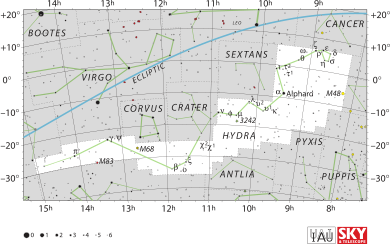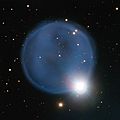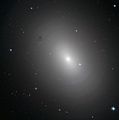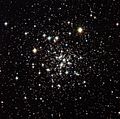Hydra (constellation) facts for kids
| Constellation | |

List of stars in Hydra
|
|
| Abbreviation | Hya |
|---|---|
| Genitive | Hydrae |
| Pronunciation |
|
| Symbolism | the sea serpent |
| Right ascension | 8–15 |
| Declination | −20 |
| Quadrant | SQ2 |
| Area | 1303 sq. deg. (1st) |
| Main stars | 17 |
| Bayer/Flamsteed stars |
75 |
| Stars with planets | 16 |
| Stars brighter than 3.00m | 2 |
| Stars within 10.00 pc (32.62 ly) | 4 |
| Brightest star | Alphard (α Hya) (1.98m) |
| Messier objects | 3 |
| Meteor showers |
|
| Bordering constellations |
|
| Visible at latitudes between +54° and −83°. Best visible at 21:00 (9 p.m.) during the month of April. |
|
Hydra is a huge constellation that stretches across both the northern and southern parts of the night sky. It's actually the biggest constellation we know! Imagine a giant water snake winding its way through the stars – that's Hydra.
Long ago, a famous astronomer named Ptolemy included Hydra in his list of 48 constellations. Today, it's still one of the 88 modern constellations recognized by the International Astronomical Union.
Even though Hydra is super big, it only has one really bright star. This star is called Alphard. Its name comes from Arabic and means "the solitary one." This is a good name because Alphard stands out by itself. Besides Alphard, the only other easy-to-spot part of Hydra is a small cluster of stars that looks like its head.
Contents
What is a Constellation?
A constellation is a group of stars that forms a pattern in the sky. People often imagine these patterns as animals, objects, or characters from myths. The stars in a constellation might look close together from Earth, but they are actually very far apart in space. They just happen to be in the same direction when we look at them.
Finding Hydra in the Sky
Hydra is so big that it can be tricky to spot all at once! It's best seen in the spring sky. You can look for its brightest star, Alphard, which is sometimes called the "heart of Hydra." The constellation's "head" is a small group of stars near the constellation Cancer. From there, the snake's body stretches out for a long distance!
Stars and Objects in Hydra
Besides Alphard, Hydra has other interesting things to see:
- Messier Objects: There are three special objects in Hydra that are part of a famous list called the Messier Catalogue. These include galaxies and star clusters.
- Planets: Scientists have found planets orbiting some of the stars in Hydra. This means there are other worlds out there!
- Meteor Showers: Sometimes, tiny pieces of space dust and rock burn up in Earth's atmosphere, creating "shooting stars." Hydra is linked to two meteor showers: the Alpha Hydrids and the Sigma Hydrids.
Images for kids
-
Planetary nebula Abell 33 captured using ESO's Very Large Telescope.
-
Elliptical galaxy NGC 3923.
-
Ancient globular cluster NGC 6535.
See also
 In Spanish: Hidra (constelación) para niños
In Spanish: Hidra (constelación) para niños







